
History will hold that the arrival of the Internet, as a commercial enterprise, marked the downfall of civilization. No invention has contributed more to the loss of civility, more to the dissemination of incorrect information or has done more to damage the fabric of society. The Internet is the inferior parent who failed to teach its children manners, respect for others or the need for knowledge ahead of opinion.
Perhaps a hostage exchange, the Internet for access to the world’s libraries could be arranged and, simultaneously, all consensus seeking and/or unfettered public expression of opinion could be halted. People would conduct independent research, arrive at their own conclusions and reach their own decisions. Advertising would be limited to quantifiable specifications and all reference to life style and ego enhancement would be eliminated. People would no longer lose their minds in the absence of homogeneous group membership or the shelter of a hatchery.
Some might ask, “Why then, Joe, do you make your goofy comments on the Internet?” Fair question. I think the issue centers around the assignment of a uniform resource locator, or URL, a web address. I have one, I live there, and I expect folks I know will come to visit for as long as they enjoy the conversation and the company. I also expect that people who don’t feel as though they benefit from the information presented will move along, past my house and not intrude when I am entertaining guests. I do not visit other publishing sites or firearm forums to share my opinions, so if someone read something I wrote, they found it at my home address.
The truth of the matter is, only about a handful of firearms warrant excitement each year, perhaps 25 or 30 out of thousands. My interests is in shooting them, handloading for them and taking them apart to see how they are made and to understand what makes them tick. When people tell me I’ve forgotten to make mention of a certain cartridge or a firearm, I can never seem to get them to understand that I didn’t forget, I just wasn’t interested enough to invest time, which is already in short supply, to write about them.
The Remington Model 700 SPS Varmint
Oddly enough, I think this relatively inexpensive rifle has beautiful lines. Form follows function and someone, or some group, at Remington figured out how to make that look good. Hand filling, but light weight. Heavy barrel profile and wide forearm, but balanced when held to the shoulder or shot prone. The matte finish on metal and synthetic pieces presents an “all business” appearance and the soft anti slip inserts add just the right touch of gray scale contrast. The Remington M700 SPS Varmint is a bit of mechanical art.
The SPS Varmint is available in: 204 Ruger, 223 Remington, 22-250 Remington, 243 Winchester, 308 Winchester. Each having a place within an application, some with overlap. A 26″ barrel, a bit of heft and a wide forearm spell long range shooting, so the 22-250 Remington seemed the likely choice. It is a cartridge that is not too heavy for prairie dog hunting and not to light for deer or pronghorn with proper bullets. I’ve never seen the 243 Winchester and 308 Winchester as particularly long range cartridges and too much cartridge for small varmints. There is a huge difference between rounds that can be shot accurately at a known distance and rounds with a generous point blank range when hunting.
In more tangible terms…
|
Remington Model 700 SPS Varmint |
|
| Point of Origin | Ilion, NY |
| Model# | 84216 |
| Action Type | Bolt Action – two lug |
| Caliber | .22-250 Remington |
| Mag Capacity | 4+1 |
| Barrel Length | 26″ CS |
| Rifling | 1:14″ |
| Weight | 8.5 Lbs |
| Overall Length | 46 1/2″ |
| Stock | Synthetic – Overmolded Panels |
| Drop at Comb / Heel | 1 3/8″ / 1 3/8″ |
| Length of Pull | 13 3/8“ |
| Sights | Clean – D&T For Scope |
| Barreled Action | Blued Carbon Steel |
| Bottom Metal | Anodized Aluminum |
| Trigger | X-Mark Pro 3 – 5 Lbs |
| Safety | Two Position Thumb |
| MSRP | $761 |
| Nominal weights and Dimensions | |
High velocity, high pressure cartridges generate a lot of heat and heat can accelerate barrel throat erosion. The Varmint’s stock is reinforced with ribbing on the interior, however, air can circulate along the underside of the barrel, aided by the side vents in the forearm, for improved cooling.

The M700 SPS Varmint is equipped with two sling swivel studs to permit simultaneous mounting of both a sling and a bipod. An appropriate accommodation for a long range shooter.
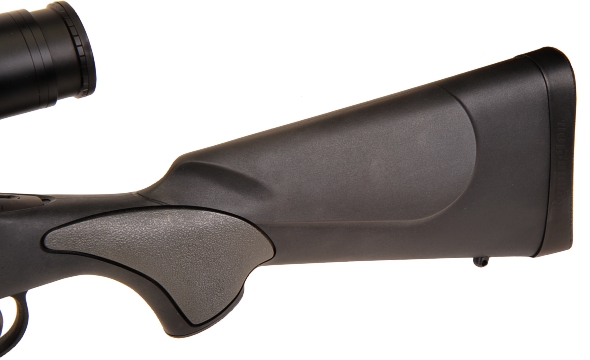
The stock’s wrist, or small of the stock, is extended a little more than typical. No palm swells; holding the rifle with finger on trigger puts the thumb right in the flute at the nose of the comb. No Monte Carlo, the drop at the comb through the heel is only 1 3/8″ for good scope eyepiece alignment, head support and recoil management.

By going big and small on the stock where appropriate, the SPS Varmint is a good 1 lbs lighter than other rifles with this barrel profile. Additionally, the rifle carries small rather than like club or a 2×4.
The action is located to the stock by the recoil lug and at the two action fasteners that are hole diameter for additional support. The interior of the stock is heavily reinforced, much the same as the bulkhead – stronger approach used in the fuselage of a large aircraft where strength and light weight are the design objectives.
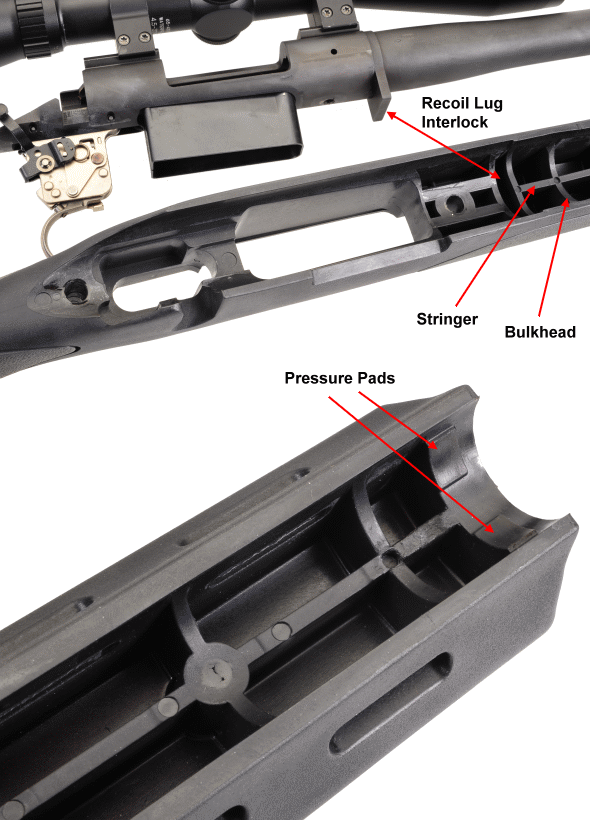
The Remington’s barrel floats from recoil lug to tip of forearm where it is supported by two pressure pads. A hundred years ago, when I was a hundred, gunsmiths and factories used to clamp and glass bed stocks and barreled actions together. Now they let them vibrate and shake as will, each to their own frequencies. Seems to work and it eliminates the need for expensive hand fitting.
The Remington Model 700 SPS Varmint has the X-Mark Pro, very slick, adjustable trigger. Set at the factory to 3 lbs, pull can be dropped a bit, up more, for a 2 lbs range of adjustment.
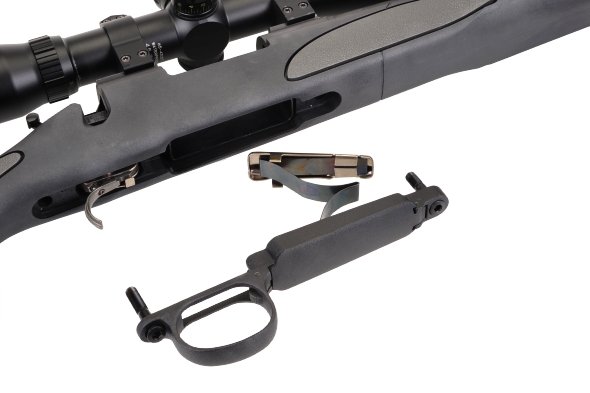
The bottom metal, trigger guard, floorplate and floorplate frame are made of aluminum with a matte textured finish. The follower is polished steel. The two cap screw fasteners that secure the clamp the stock between the bottom metal and barreled action have gone metric with a 4mm socket head.
The 22-250 Remington…
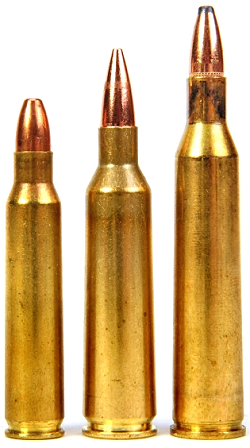
In the world of hotrod 0.224″ rounds, I am generally a 220 Swift shooter with a Remington’s VS SF II my rifle of choice, however, I do handload and shoot both the 220 Swift and 22-250 Remington. Pictured L-R, 223 Remington, 22-250, 220 Swift. Folks who own 22-250 Remington chambered rifles will tell you that it will match the Swift, but that just isn’t true.
Nominally, at a 40 grain bullet weight, the Swift will clock along at 4,400 fps, compared to 4,100 for the 22-250 Remington on the best of days. Bump that bullet weight to 50 grains and the Swift will hold 4,100 and the 22-250 Remington will drop to 3,700 fps. The 22-250 Remington has 43.5 grains of H2O capacity and operates at 65,000 psi. The 220 Swift holds 47.0 grains and operates at 62,000 psi. Both put the 223 Remington to shame.
So why a 22-250 Remington and not a 220 Swift? No, not because the 220 Swift is a barrel burner. There are actually a good number of cartridges that have higher capacity to bore ratios, run at a higher pressure and temperature, and have longer burn persistence. The best reasons are that there are many more factory rifles available for the 22-250 Remington and both ammunition and reloading components are generally when 220 Swift ammo and components are frequently out of stock.
As a handloader, I can usually get around 220 Swift ammo shortages by buying brass. When brass is in short supply, I can use a swaging press to make cases from 270 Winchester brass, but that is not a casual undertaking. Today there are 45 commercial loads being made for the 22-250 Remington, about half are in stock at any given time. There are 6 commercial loads for the 220 Swift and none of them are in stock. Brass is readily available for the 22-250 Remington, zero for the 220 Swift. I am not suggesting the 22-250 Remington is a big compromise. It has a lot of reach, it is well behaved and, except at the far edges, it can run with the 220 Swift.
What now?
We’ll pick a few bullets, find some good handloads and see how the Remington Model 700 SPS Varmint shakes out. If we have time, maybe we can put a number of the value of a vented forearm.
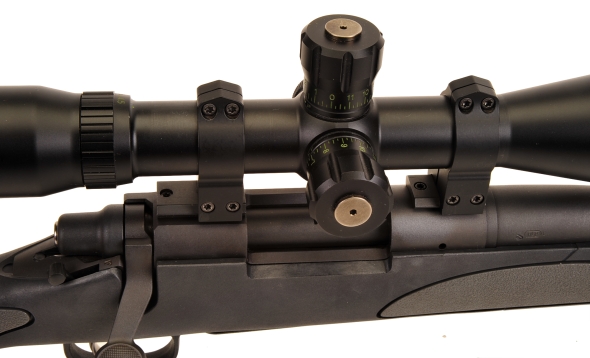

Email Notification